In the gym, simple training does not always mean easy training. Some of the most simple-looking exercises can be the most challenging, as well as the most beneficial. Many lifters are familiar with the basic squat movement and the lower body benefits it delivers. But squatting with a barbell isn’t the only option.
Many lifters overlook the seemingly simple goblet squat, presuming it’s too easy to deliver results or that the exercise is more useful for beginners than experienced lifters. Both are wrong.
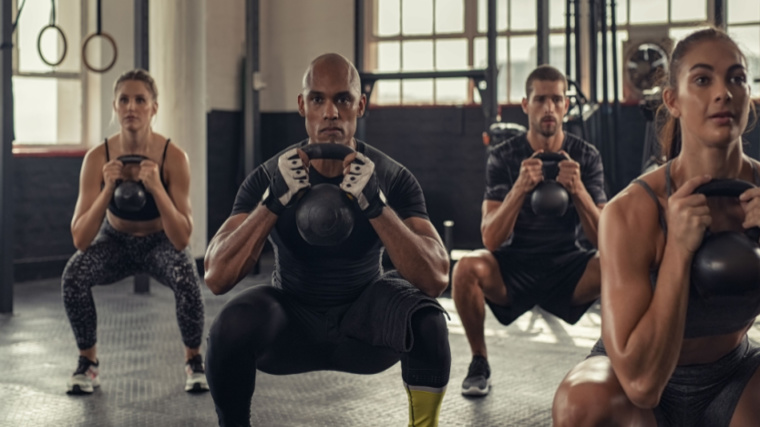
The goblet squat can improve upper back strength, build hip and ankle mobility, deliver an intense core workout, and create a deep muscle-building burn in your quads and glutes that will make you equally love and hate this exercise. Here’s how to do it.
- How to Do the Goblet Squat
- Common Mistakes to Avoid
- Benefits of the Goblet Squat
- Muscles Worked by the Goblet Squat
- Who Should Do the Goblet Squat
- How to Program the Goblet Squat
- Goblet Squat Variations
- Goblet Squat Alternatives
- Frequently Asked Questions
How to Do the Goblet Squat
Although this is predominantly a lower body exercise, what’s happening with your upper body is also important. Holding the weight in a strong position will allow your upper body to remain stable while your legs do the lion’s share of the work.
Step 1 — Secure the Weight and Set Your Stance

Use both hands to lift a kettlebell or use a dumbbell by holding the weight plates on one end. Bend your arms and allow the weight to sit under your chin. Pull your elbows tight into your body for a strong upper back position. Create tension in your core to ensure a neutral spine.
Position your feet slightly wider than hip-distance apart. Turn your toes slightly outward, no more than 45-degrees, to allow a healthy knee position.
Form tip: Imagine holding a towel between your arms and torso to maintain a tight elbow position, which supports the weight and engages your upper back. To fine-tune your stance, jump before picking up the weight. Your feet will naturally find a position for a safe landing. That is a stable position for the squat.
Step 2 — Squat Straight Down

With the load in front of your body, it’s easier to keep your torso vertical during the squat, which makes it more knee-dominant than hip-dominant (this affects muscle recruitment and emphasizes your quadriceps).
Allow your hips to travel down while your knees reach forward over your toes. Your elbows will fall between your thighs as you reach the bottom position. Keep your torso stacked over your hips to achieve a longer range of motion and more core engagement. Leaning forward can stress your lower back. Keep your weight distributed over your midfoot without rising onto your toes or excessively pressing through your heels.
Form tip: In the bottom position, the forward angle from your ankles to knees should be similar to the forward angle from your hips to shoulders. This optimizes power and muscle recruitment without excessive joint strain.
Step 3 — Stand Up to Lockout
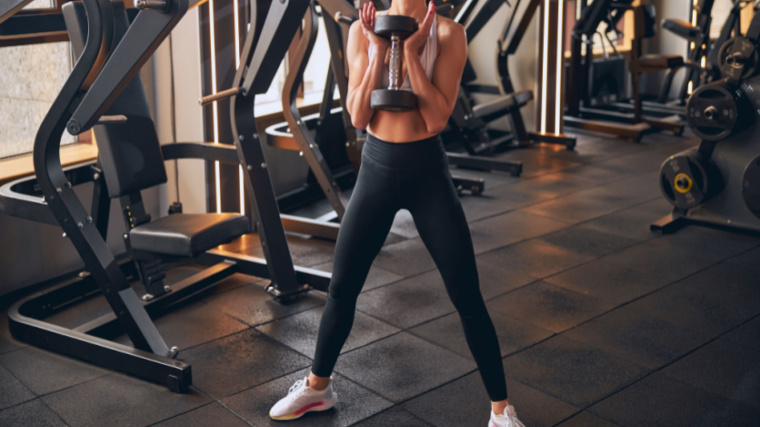
Push down into the floor with your whole foot to stand straight up. Maintain your torso stacked over your hips. Don’t exaggerate a hip thrust as you reach the top of the movement. Hold the weight securely. Don’t relax your arms as you drive with your legs and don’t press the weight up.
Exhale steadily through pursed lips as you stand up. Finish fully exhaling at the top to maintain intra-abdominal pressure and increase core stability.
Form tip: The more you push down into the floor, the more hip extension you’ll create at the top of the movement. For an extra burn, keep pressing into the floor at the top of the rep to maximize muscle tension.
Goblet Squat Mistakes to Avoid
Make sure you get the most bang for your buck when performing the goblet squat. Although this exercise may look simple, there are a few things you want to avoid.
Not Using a Full Range of Motion
Achieving a full range of motion may look different person to person, depending on their individual limb lengths and mobility, but you find the best muscle-building stimulus when utilizing the greatest range of motion possible. (1)
View this post on Instagram
One of the most common mistakes is hinging the hips far back before squatting, like you’re doing a powerlifter’s back squat. This prevents you from reaching a significant squat depth and it can short-change muscle recruitment.
You might’ve heard that your knees should never go over toes when squatting. That’s incorrect. Letting your knees move over your toes is the only way to safely get to the bottom of the squat.
Avoid it: To get a full range of motion with the goblet squat, focus on achieving a deeper knee bend instead of just pushing your hips back. You may need to gradually build up your tolerance and mobility to reach full depth because your body is building strength as it explores new ranges of motion.
Standing with Your Butt First
A common problem when transitioning into the standing position is letting your hips rise first. When this happens, your glutes go into the air and the weight, along with your torso, tip forward. As you can visualize, this ends up looking like some kind of exotic dance maneuver and is sometimes referred to as a “stripper squat.”

This forward-body position places more stress on the lower back and turns the movement into a hip dominant movement, requiring your hamstrings and glutes to complete the lift. Not only can your lower back get strained, but your quadriceps muscles are left out of the movement.
Avoid it: Pause for one or two seconds at the bottom of each rep to make sure you’re in a good position to drive up. Focus on keeping the weight tight to your body and maintain a fully engaged upper back to stay vertical as you stand up.
Benefits of the Goblet Squat
The goblet squat trains the fundamental squat pattern which improves size, strength, and mobility throughout the lower body. Here are more details about using the goblet squat.
More Muscle
Taking muscles through a long range of motion is an important factor for muscle hypertrophy and there are not many better exercises than the goblet squat when it comes to squatting deep. This movement sets you up for leg-building success. Right now, thick thighs and well-built glutes are the new “abs and biceps” for many people, and the goblet squat can help.
Better Mobility
The goblet squat can help improve mobility in your ankles, hips, and upper back. Holding the weight in front of your body shifts our center of mass backwards. Shifting the weight back allows the ankles to work through a longer range of motion throughout each rep.
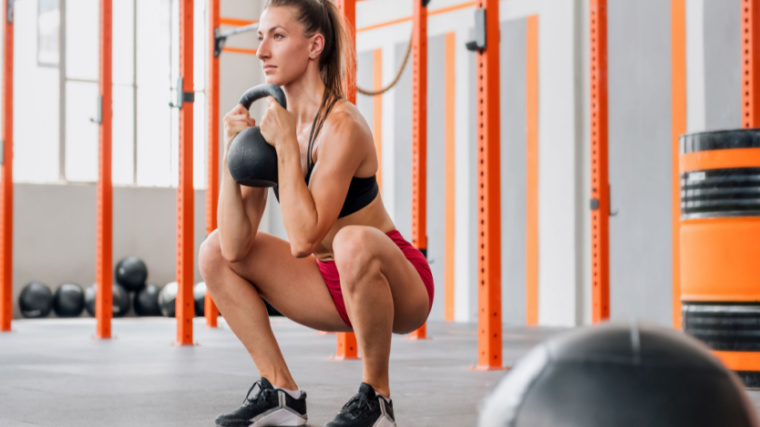
Taking any joint through more range of motion while under load is going to improve your mobility more effectively than any static drill or foam rolling.
Muscles Worked by the Goblet Squat
Like many leg exercises, the goblet squat works a number of muscle groups in the lower body including the quadriceps, glutes, adductors, and hamstrings.The unique position of the weight also works your core more significantly than other squat variations.
Quadriceps
The quadriceps are made up of separate heads that work together — the vastus lateralis, vastus intermediate, vastus medialis, and rectus femoris. The upright torso position and long range of motion at the knees and hips significantly recruits the quadriceps to straighten your legs (knee flexion).
Adductor Magnus
This muscle on the back of the thigh is recruited most when performing a large amount of hip flexion (bending at the hips). Although it primarily works when moving laterally, it’s highly activated during the goblet squat as the muscle helps to initiate hip extension from the bottom position, before the glutes come to the party closer to full extension. (2)
Glutes
One of the main functions of the glutes is hip extension, straightening the leg in line with the upper body. When performing a goblet squat through a long range of motion, your legs go through greater hip flexion. The more hip flexion performed, the greater the opportunity to work the glutes.
Core
Your core is composed of a number of different muscles including the transverse abdominals, the rectus abdominis, and the obliques. Each muscle performs a different action on the torso — creating stability, preventing rotation or collapsing, and maintaining intra-abdominal pressure to reduce lower back strain.
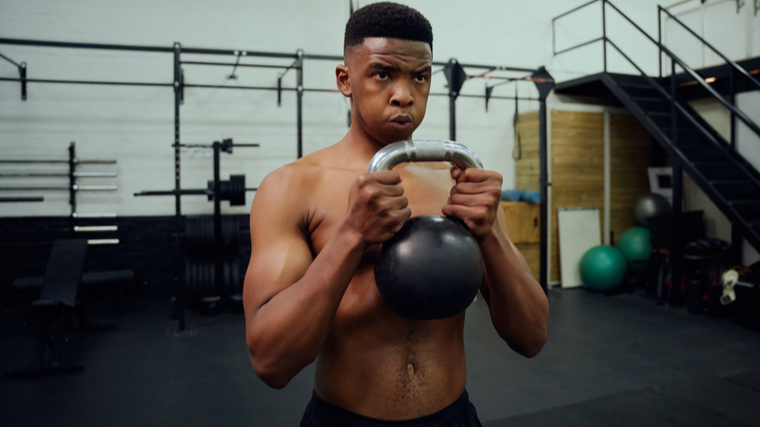
To successfully target and strengthen these muscles, be sure to maintain positions where your head, torso, and pelvis are all stacked. The goblet squat allows you to find and drill that position.
Who Should Do the Goblet Squat
The goblet squat can be performed by any individual whether they are a beginner, intermediate, or advanced lifter. It can be a great exercise for hypertrophy, fat loss and body composition changes, and also athletic development.
Training for Fat Loss and Improved Body Composition
The goblet squat can be an effective movement for improving body composition. The exercise takes muscles through a long range of motion, which is good for maintaining and/or improving lean muscle mass during a dieting phase.
This specific movement doesn’t require a lot of axial loading (compression stress on the spine) which can be more common with other squat variations. This makes it easier to perform the goblet squat more frequently and consistently with good form.
Athletic Training
For general sports athletes, strength is underrated. Some are still worried about becoming “muscle-bound.” But athletes also don’t need to become dedicated bodybuilders, so it’s important to have a good mix of exercises where they can focus on building basic strength, while also including exercises like the goblet squat where they can maintain functional positions while moving and creating force.
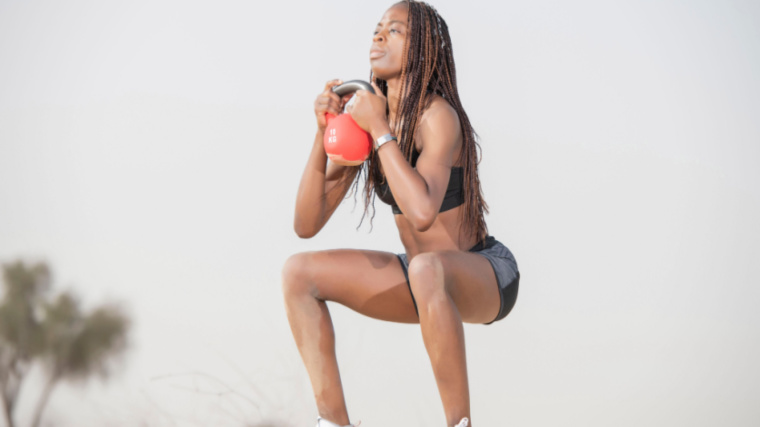
Athletes can also vary the programming of the goblet squat, manipulating load and volume for more strength or hypertrophy, or performing the exercise with lighter loads and a slower tempo (rep speed) for more of a core challenge.
Hypertrophy
The goblet squat can be a good option for hypertrophy (muscle growth) because the exercise takes muscles through a long range of motion. However, the goblet squat will eventually be limited by how much weight you can hold.
If or when this happens, the goblet squat would still be useful as an “accessory” movement performed later in the workout when your leg muscles are pre-fatigued from other training, instead of using the goblet squat as main lift.
How to Program the Goblet Squat
Like many exercises, the goblet squat can be programmed differently depending on your goals. Here are a few of the most effective ways to program the goblet squat.
Moderate-to-Heavy Load, Lower Repetition
There are two very effective ways to program the goblet squat with relatively heavy loads. The first is using EMOM (every minute on the minute), where you perform five or six reps at the start of each minute and rest for the remaining time, repeated for six or seven total minutes. The accumulation of fatigue will increase the intensity significantly, especially in rounds three through six.
The other option is to use tempo training — the speed at which you perform the exercise. Tempo is normally expressed using a series of four numbers, each number representing a section of the rep. For example, 4-2-1-0 would indicate four seconds on the way down, two seconds paused in the bottom position, one second to return up, and zero seconds in the top position before the next rep.
Lighter Load, Higher Repetition
The goblet squat can be used as a good pre or post-exhaust on a leg day, performed immediately before or after another leg exercise. Two or three sets of 12 to 15 reps work well for this. Because it only requires one weight, it can also be used as a convenient and efficient part of a circuit where you can move quickly with minimal rest in between multiple exercises.
Goblet Squat Variations
There are a few variations of the goblet squat that you can alternate between during different phases of your training, for specific benefits beyond the basic movement, and/or to give you some general training variety.
Heels-Elevated Goblet Squat
Some gyms have a solid heel wedge device or you can place small plates under your heels. If you’re at home or in a garage gym, you could roll up an exercise mat or use a thick book. This is a really great way to learn the general movement pattern because the angle encourages you to keep your torso upright. Because it’s easier to keep your body stacked, you’ll likely feel this a lot more in your core, as well as your legs.
The elevated heel position increases quadriceps recruitment due to the altered leg angle. The higher heel position can also act as assistance for lifters with poor ankle mobility, allowing them to reach a lower squatting position than standing flat on the floor.
B-Stance Goblet Squat
The “b-stance” is a unique position where one foot is set in pace and the other is shifted back slightly, acting as a kickstand for balance. This is a great way to introduce single-leg training, as it offers the benefits of unilateral (single-leg) training such as addressing muscle discrepancies, but it also doesn’t require as much balance or coordination as more challenging single-leg exercises.
The B-stance goblet squat shouldn’t turn into a lunge. Instead of taking a full step backwards, set one foot very slightly back — having the toes of one foot roughly in line with the heel of the other foot.
Goblet Squat Alternatives
Front Squat
The front squat can be a highly effective alternative to the goblet squat. Holding a barbell across the front of your shoulders allows potentially heavier loads than the goblet squat, which can contribute to greater strength gains.
The front squat can be performed with a similar range of motion and develops muscle and mobility similar to the goblet squat.
Step-Up
The step-up starts from a position of hip flexion, rather than starting in a standing position and descending into a squat, which makes it a good alternative if you experience discomfort during hip flexion.
The step height can also be adjusted to accommodate any mobility limitations. It can be difficult to increase load on this exercise because of the total-body challenge and balance requirements, but it still delivers a very big bang for the buck.
FAQs
Why can’t I lift as much weight with the goblet squat compared to a barbell back squat?
This is a very common situation and it comes down to muscle recruitment and leverage. The barbell back squat is often more of a hip-dominant movement with relatively less range of motion, which allows you to move more total weight. Because the bar is supported across your upper back and shoulders during a back squat, it removes the limitation of holding the weight in your hands.
The back squat can be a better choice specifically for strength gains, but for general improvements in body composition and athletic development, the goblet squat could be the more favorable choice.
How many times per week should I do goblet squats?
The goblet squat puts the body through less axial stress and loading (compression of the spine) compared to various barbell squats, so you could perform the goblet squat more frequently — two to three times per week.
If you are performing the exercise multiple times per week, vary the programming in each workout to get a range of training stimuli. For example, perform higher reps in one session, use different tempo in the next workout, and use a variation like B-stance goblet squats in the last workout of the week.
Life is Full of Ups and Downs. We Call Them Squats.
Maturing in fitness is realizing that there is no “best” exercise. A well-rounded lifter should eventually want to develop a list of effective movements they can perform very well. Include the goblet squat and its variations in your routine, and you should find that progressing with one movement carries over to improve other squat exercises. Never underestimate the simple goblet squat. It is simple, but not easy.
References
- Schoenfeld, B. J., & Grgic, J. (2020). Effects of range of motion on muscle development during resistance training interventions: A systematic review. SAGE open medicine, 8, 2050312120901559. https://ift.tt/eFfCGhM
- Keitaro Kubo, Toshihiro Ikebukuro, Hideaki Yata, Effects of squat training with different depths on lower limb muscle volumes – https://ift.tt/QXvbuJd
Featured Image: Photology1971 / Shutterstock
The post How to Do the Goblet Squat for Lower Body Size and Mobility appeared first on Breaking Muscle.

0 Comments